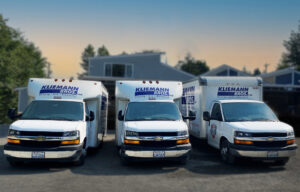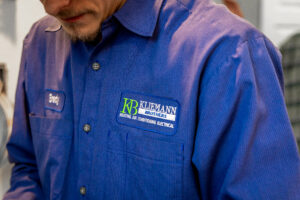The Benefits of Ductless Heating and Cooling for Your Home

As an alternative to conventional ductwork-based HVAC, mini-splits are ductless systems that keep your home comfortable with targeted zoning, high energy efficiency, and other advantages. Learn about ductless heating and cooling benefits and if you should consider switching to a ductless system.
What Is a Ductless Heating and Cooling System?
Ductless heating and cooling systems, also known as mini-split systems, are an alternative to traditional HVAC setups that require ductwork. While central AC and forced-air systems circulate warm or cool air throughout your home via air ducts, a ductless system delivers it directly to specific rooms or zones.
A ductless system consists of:
- Outdoor compressor unit: The outdoor unit houses the compressor, condenser coil, fan, and other parts. It either absorbs heat from outside to warm your home or expels it outside to lower the indoor temperature.
- Indoor air-handling units: Mini-splits have one or more heads, or air handlers, which distribute and draw in air. They each house an evaporator coil, air filter, blower fan, and temperature sensors.
- Refrigerant lines and wiring: Insulated copper tubes carry refrigerant between the outdoor and indoor units. The electrical wiring supplies power to and enables communication between these units.
Ductless mini-splits use heat pump technology to transfer heat rather than generate it. In cooling mode, the air handlers draw in warm air and blow it over the evaporator coil, and the refrigerant in the coils absorbs heat. The refrigerant travels to the outdoor unit, which releases heat. In heating mode, this process reverses — the outdoor unit absorbs heat from outside and transfers it indoors, where the air handler distributes warm air. The reverse valve switches the system between cooling and heating modes as needed.

Why Consider Switching to a Ductless System?
Mini-splits are increasingly popular in Tacoma and other areas due to their many advantages, including versatile functionality and simple installation.
Zoned Heating and Cooling
Ductless systems enable independent temperature settings in each room or zone. This helps eliminate cold or hot spots or accommodate different temperature preferences in your household. Instead of cranking up the heating or cooling to warm up one room with substandard airflow, multiple heads let you maintain different temperatures, and you can scale your system up and expand as needed without replacing the equipment. This is especially advantageous for:
- Basements, garages, sunrooms, and other areas lacking ductwork
- Renovations or home additions without existing HVAC
- Supplementing underpowered or less efficient forced-air systems
Easy Installation and No Major Renovations
Installing, repairing, or reconfiguring ductwork for traditional HVAC systems may require significant renovations, such as demolishing and reinstalling drywall to access ducts.
In comparison, installing a ductless system only requires mounting the indoor and outdoor units and connecting refrigerant lines and electrical wiring through small holes in the walls, with no need to tear down walls or ceilings. There are also several types of indoor units with different mounting capabilities, which let you choose between mounting air handlers on the wall, ceiling, or floor.
Quiet operation
Noise plays an important role in home comfort, and mini-split systems are significantly quieter than traditional HVAC systems. Central ACs and furnaces operate at 50 to 70 decibels, equivalent to a normal conversation, and aren’t generally disruptive. Ductless systems, however, range between 25 and 35 decibels, rarely exceeding the equivalent noise of a whisper or light rainfall.
Year-round solution
With heat pump technology and a reversing valve that enables both heating and cooling, ductless systems are a year-round solution. Mini-splits maintain high efficiency even throughout Tacoma’s colder months, and some higher-end models maintain efficiency even when temperatures dip below 20 degrees.
Ductless systems can also integrate with and supplement existing HVAC systems to optimize energy consumption depending on the temperature. For example, mini-splits can provide high energy efficiency during milder winter temperatures, and gas furnaces kick on during more severe conditions to provide more powerful backup heating.
Sustainability
Ductless systems are a great choice for homeowners who prioritize sustainability. By reducing energy consumption, ductless systems lower fossil fuel use and subsequent greenhouse gas emissions. Transferring heat instead of generating it makes ductless an eco-friendly alternative to fossil fuel-based systems, such as gas furnaces or oil boilers that release carbon monoxide and other combustion gases.
Advanced Technology
Ductless systems are engineered for efficiency and convenience. They feature advanced technology and components, such as inverter-driven compressors that reduce energy consumption. Mini-splits also have high-quality parts that may need less frequent repair or maintenance than old or outdated HVAC systems.
Energy Efficiency and Cost Savings with Ductless HVAC
Reduced energy consumption and cost savings are among the main advantages of energy-efficient heating and cooling systems.
Reduced energy consumption
Ductless mini-splits offer dramatically higher efficiency ratings over most other HVAC systems, which translates to lower energy bills. Seasonal energy efficiency ratio (SEER) ratings measure how much power a unit uses compared to its output — most Energy Star-rated ACs range from 14 to 17 SEER, sometimes reaching 26. In comparison, some ductless systems can achieve up to about 40 SEER. And compared to other heating options, some ductless systems use up to 60% less energy than standard electric radiators.
Several factors allow for high mini-split efficiency:
- No ductwork loss: Ductwork leaks account for up to 30% of energy consumption since they allow warm or cool air to escape and force the system to work harder. With ductless systems, air is distributed directly to the target area, minimizing energy loss.
- Targeted zoning: Zoned areas allow you to heat or cool rooms as needed rather than applying one temperature across your entire home.
- Variable-speed compressor: Using inverter technology, variable-speed compressors continually adjust according to heating or cooling demand to prevent energy spikes and enable more consistent indoor temperatures.
Rebates and Incentives
Many utility companies, federal tax credits, state programs, and other organizations offer rebates and incentives for switching to a ductless system. These incentives offset the upfront cost of installation in exchange for upgrading to a more sustainable HVAC option.
Is Your Home a Good Fit for a Ductless System?
Ductless mini-split systems are efficient, versatile, and cost-effective, but they don’t necessarily fit every scenario. For homes with central HVAC and ductwork in good condition, switching to a mini-split system may not be the most cost-effective long-term. Homes that are subject to extremely cold temperatures may need a more robust heating source.
Otherwise, any of these conditions mean that your home may be a good candidate for ductless HVAC:
- Your home has multiple levels with different temperature needs.
- You want to add heating or cooling to home additions, basements, garages, or other spaces lacking HVAC.
- You live in an older or character-style home that doesn’t have existing ductwork.
- Your current HVAC system needs replacement or additional support.
How to Upgrade to a Ductless System
Here’s what to expect when you upgrade to a ductless system:
- Assessment: Our technicians calculate your home’s heating and cooling needs and recommend the ideal ductless model, system size, and configuration.
- Professional installation: We complete most mini-split installations within one day. Your technician performs a post-installation inspection to ensure safe and efficient operation.
- Ongoing maintenance: After a walkthrough of your new system, our technicians offer maintenance and care tips to keep your system performing at its best.

Contact Kliemann Bros for Expert Ductless HVAC Installation
Experience the benefits of ductless heating and cooling when you choose Kliemann Bros for HVAC installation and more. Contact us today to enjoy energy-efficient and eco-friendly home comfort.
